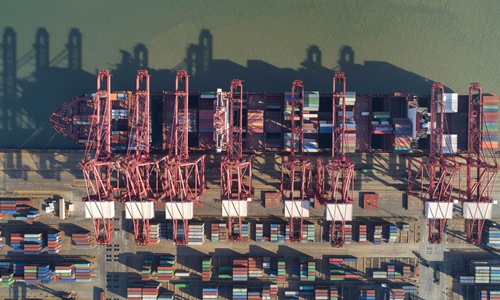China’s trade yet to recover as COVID-19 situation worsens in EU, US
Chinese ports get back to work as epidemic wanes

Workers load containers onto a ship in Lianyungang Port in Jiangsu East China's Jiangsu Province on Sunday. Photo: cnsphoto
China's foreign trade is recovering as the COVID-19 outbreak shows signs of abating amid the country's all-out efforts to contain it in the past few weeks. But the recovery pace is slower than expected due to challenges from worsened situations in Europe and the US.
It has raised worries that the pandemic could lead to a continuous drop in business between China and the two significant trade partners.
Major ports in the world's largest exporter, which are widely seen as a measurement of foreign trade, were hit hard during the epidemic, but as China has encouraging nationwide work resumption, they have all reported progress in March - delayed goods are getting cleared, business volume is recovering and ship flows are rising.
China's Ningbo-Zhoushan port, the busiest in China in terms of cargo tonnage, said in a statement it sent to the Global Times that its business is doing better now than in February, when its throughput dropped 20 percent year-on-year due to the dual impacts of the holidays and the virus outbreak.
The port, which handles all types of goods from daily small commodities to crude oil and iron ore, has 192 international shipping lines covering almost all major ports in countries and regions around the world. North America, Europe and the Mediterranean lines account for a high market share.
The Yangshan Deep-water Port in Shanghai also reported rising ship flows from March, compared with an "obvious drop" from late January to middle February.
The Port of Guangzhou, the world's fifth-largest, managed to clear its backlogs caused by logistics congestion during the outbreak of the COVID-19 in China since January.
Despite the "unprecedented pressure and difficulties faced by industries across the board, and the coupled effects of Spring Festival holidays and the COVID-19 outbreak," the port's backlogs since January have been eased by extending stockpile capacity and expediting shipping services, the port said in a statement sent to the Global Times.
Nevertheless, despite recovery signs, a full bounce still hangs in the air. "Due to the impact of foreign epidemic factors at this stage, a return to normal may continue to be delayed," the Ningbo-Zhoushan port said.
"An escalating global situation will not only affect ports' operation, but will also delay the resumption work of exporters across the country, either from the supply chain or demand aspects," Wang Jun, Chief economic at Zhongyuan Bank Co, told the Global Times on Sunday.
According to information the port revealed, exports of daily necessities from Yiwu, East China's Zhejiang Province, also the world's leading small commodities market, have recovered to 50 percent of the normal level. Chinese exporters said they are worried a worsened situation would further slash their profits for the full year and they expect slowing demand from the US and Europe.
Though existing orders have not been affected so far, the accelerating pandemic outside of China has appeared to have a more far-reaching impact on revenue, Wei Guoxian, general manager of Jiangsu Shengli Tools Co, a hardware tool producer located in Danyang, East China's Jiangsu Province, told the Global Times on Sunday.
The export-oriented company's major markets are the US and countries and regions in the framework of the Belt and Road Initiative (BRI). Its production has fully resumed as epidemic in China has eased, according to Wei.
Wei said it will be a tough year and the negative effects will show up soon. Normally, the company could see annual revenue growth of 20 percent, however, it has reset its revenue target this year to "not losing money" due to the pandemic, he said.
Same concerns were listed by a textile export company located in Qingdao, East China's Shandong Province. "Delivery of our products has resumed about 60-70 percent," the company's merchandising manager surnamed Wang told the Global Times.
In the January-February period, China's overseas shipments dropped by 17.2 percent from the same period a year earlier, customs data showed on March 7, the steepest fall since February 2019. Meanwhile, imports sank 4 percent from a year earlier.

